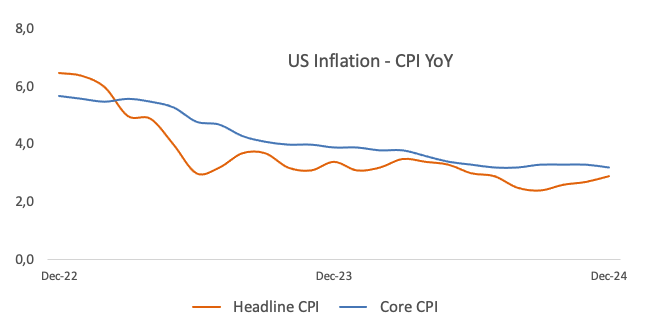Inflation in the US, as measured by the change in the Consumer Price Index (CPI), rose 2.9% on a yearly basis in December from 2.7% in November, the US Bureau of Labor Statistics (BLS) reported on Wednesday. This reading came in line with market expectations. On a monthly basis, the CPI rose 0.4%, following the 0.3% increase recorded in the previous month.
Follow our live coverage of the market reaction to the US inflation data
The core CPI, which excludes volatile food and energy prices, rose 3.2% on a yearly basis—below November’s gain and analysts’ estimates for a 3.3% increase. The monthly core CPI rose 0.2% in the last month of 2024.
Market reaction to US CPI readings
The Greenback rapidly breaks below the 109.00 support when tracked by the US Dollar Index (DXY) in the wake of the release of US CPI data, hitting at the same time new multi-day lows.
US Dollar PRICE Today
The table below shows the percentage change of US Dollar (USD) against listed major currencies today. US Dollar was the strongest against the Canadian Dollar.
| USD | EUR | GBP | JPY | CAD | AUD | NZD | CHF | |
|---|---|---|---|---|---|---|---|---|
| USD | -0.37% | -0.69% | -1.00% | -0.27% | -0.63% | -0.65% | -0.38% | |
| EUR | 0.37% | -0.32% | -0.66% | 0.08% | -0.26% | -0.28% | -0.01% | |
| GBP | 0.69% | 0.32% | -0.35% | 0.42% | 0.06% | 0.04% | 0.30% | |
| JPY | 1.00% | 0.66% | 0.35% | 0.73% | 0.38% | 0.36% | 0.61% | |
| CAD | 0.27% | -0.08% | -0.42% | -0.73% | -0.36% | -0.37% | -0.12% | |
| AUD | 0.63% | 0.26% | -0.06% | -0.38% | 0.36% | -0.02% | 0.23% | |
| NZD | 0.65% | 0.28% | -0.04% | -0.36% | 0.37% | 0.02% | 0.25% | |
| CHF | 0.38% | 0.00% | -0.30% | -0.61% | 0.12% | -0.23% | -0.25% |
The heat map shows percentage changes of major currencies against each other. The base currency is picked from the left column, while the quote currency is picked from the top row. For example, if you pick the US Dollar from the left column and move along the horizontal line to the Japanese Yen, the percentage change displayed in the box will represent USD (base)/JPY (quote).
This section below was published as a preview of the US Consumer Price Index (CPI) data at 11:45 GMT.
- The US Consumer Price Index is set to rise 2.9% YoY in December.
- The core CPI inflation is seen steady at 3.3% last month.
- The Fed is widely anticipated to keep interest rates unchanged in January.
The US Consumer Price Index (CPI) report for December, a critical gauge of inflation, is set to be released on Wednesday at 13:30 GMT, courtesy of the Bureau of Labor Statistics (BLS).
The release of the CPI figures could boost the US Dollar's (USD) upward momentum, though it’s unlikely to prompt any immediate changes in the Federal Reserve’s (Fed) monetary policy plans, at least in the very near term.
What to expect in the next CPI data report?
Inflation in the US, as measured by the Consumer Price Index (CPI), is expected to rise by 2.9% annually in November, up slightly from 2.7% in November. Core CPI inflation, which strips out the more volatile food and energy categories, is projected to hold steady at 3.3% from a year earlier.
On a monthly basis, forecasts suggest a 0.3% increase for the headline CPI and a 0.2% rise for core CPI.
Previewing the report, analysts at TD Securities noted: “We look for core inflation to step down a touch after four reports where it printed firmer 0.3% m/m expansions. We expect goods deflation to act as a key drag, helping to offset a likely rebound in housing inflation. On a y/y basis, headline CPI inflation is expected to inch higher to 2.9% while core inflation likely closed the year unchanged at 3.3% y/y.”
According to the release of the FOMC Minutes of the December 17-18 meeting, Fed officials voiced worries about growing risks of inflation trending higher and highlighted how potential shifts in trade and immigration policies could complicate efforts to bring it under control. The Minutes made several references to the potential economic and inflationary impact of these policy changes, underscoring their importance in shaping the US economic outlook.
How could the US Consumer Price Index report affect EUR/USD?
The incoming Trump administration is expected to take a stricter stance on immigration, adopt a more relaxed fiscal policy, and reintroduce tariffs on imports from China and Europe. These factors, combined with a resilient labour market, are likely to put upward pressure on inflation and have already started to reshape investor expectations. Markets now anticipate that the Federal Reserve will cut interest rates by just 25 basis points this year, keeping the outlook for the US Dollar stable for now.
However, with the US labour market cooling at a slow pace and inflation remaining stubbornly high, the December inflation report is unlikely to prompt any major shifts in the Fed’s monetary policy. Currently, CME Group’s FedWatch Tool indicates a 97% probability that the Fed will leave rates unchanged at its January 29 meeting.
Turning to the EUR/USD, Pablo Piovano, Senior Analyst at FXStreet, shares his technical outlook. He identifies the 2025 low of 1.0176 (January 13) as the first key support level, followed by the psychological parity mark of 1.0000. If parity breaks, the pair could test the November 2022 low of 0.9730 (November 3).
On the upside, resistance lies at the 2025 high of 1.0436 (January 6), seconded by the provisional 55-day Simple Moving Average (SMA) at 1.0516, and the December peak of 1.0629 (December 6). Pablo also notes that the daily Relative Strength Index (RSI) has bounced off the oversold territory. However, he cautions that any recovery is likely to be modest and short-lived.
Inflation FAQs
Inflation measures the rise in the price of a representative basket of goods and services. Headline inflation is usually expressed as a percentage change on a month-on-month (MoM) and year-on-year (YoY) basis. Core inflation excludes more volatile elements such as food and fuel which can fluctuate because of geopolitical and seasonal factors. Core inflation is the figure economists focus on and is the level targeted by central banks, which are mandated to keep inflation at a manageable level, usually around 2%.
The Consumer Price Index (CPI) measures the change in prices of a basket of goods and services over a period of time. It is usually expressed as a percentage change on a month-on-month (MoM) and year-on-year (YoY) basis. Core CPI is the figure targeted by central banks as it excludes volatile food and fuel inputs. When Core CPI rises above 2% it usually results in higher interest rates and vice versa when it falls below 2%. Since higher interest rates are positive for a currency, higher inflation usually results in a stronger currency. The opposite is true when inflation falls.
Although it may seem counter-intuitive, high inflation in a country pushes up the value of its currency and vice versa for lower inflation. This is because the central bank will normally raise interest rates to combat the higher inflation, which attract more global capital inflows from investors looking for a lucrative place to park their money.
Formerly, Gold was the asset investors turned to in times of high inflation because it preserved its value, and whilst investors will often still buy Gold for its safe-haven properties in times of extreme market turmoil, this is not the case most of the time. This is because when inflation is high, central banks will put up interest rates to combat it. Higher interest rates are negative for Gold because they increase the opportunity-cost of holding Gold vis-a-vis an interest-bearing asset or placing the money in a cash deposit account. On the flipside, lower inflation tends to be positive for Gold as it brings interest rates down, making the bright metal a more viable investment alternative.
Information on these pages contains forward-looking statements that involve risks and uncertainties. Markets and instruments profiled on this page are for informational purposes only and should not in any way come across as a recommendation to buy or sell in these assets. You should do your own thorough research before making any investment decisions. FXStreet does not in any way guarantee that this information is free from mistakes, errors, or material misstatements. It also does not guarantee that this information is of a timely nature. Investing in Open Markets involves a great deal of risk, including the loss of all or a portion of your investment, as well as emotional distress. All risks, losses and costs associated with investing, including total loss of principal, are your responsibility. The views and opinions expressed in this article are those of the authors and do not necessarily reflect the official policy or position of FXStreet nor its advertisers. The author will not be held responsible for information that is found at the end of links posted on this page.
If not otherwise explicitly mentioned in the body of the article, at the time of writing, the author has no position in any stock mentioned in this article and no business relationship with any company mentioned. The author has not received compensation for writing this article, other than from FXStreet.
FXStreet and the author do not provide personalized recommendations. The author makes no representations as to the accuracy, completeness, or suitability of this information. FXStreet and the author will not be liable for any errors, omissions or any losses, injuries or damages arising from this information and its display or use. Errors and omissions excepted.
The author and FXStreet are not registered investment advisors and nothing in this article is intended to be investment advice.
Recommended content
Editors’ Picks

EUR/USD stays in tight range near 1.0400 ahead of US data
EUR/USD moves sideways at around 1.0400 on Thursday. The pair struggles to gain traction as US President Trump's tariff threats against the EU and expectations for a dovish ECB outlook make it difficult for the Euro to find demand ahead of US data.

GBP/USD stabilizes around 1.2300 as USD holds ground
GBP/USD fluctuates near 1.2300 in the second half of the day on Thursday. The pair meets supply as the US Dollar stabilizes and traders digest US President Trump's tariff talks, gearing up for the mid-tier US economic data later in the day.

Gold retreats to $2,750 area from multi-month high set on Wednesday
Gold retreats from the multi-month high it set above $2,760 on Wednesday and trades at around $2,750 on Thursday. The 10-year US Treasury bond yield stays in positive territory above 4.6% ahead of US data, not allowing XAU/USD to build on its weekly gains.

Bitcoin edges below $102K ahead of mid-tier US data and Trump’s tariff threats
Bitcoin’s (BTC) price continues to decline, trading below $102,000 at the time of writing on Thursday after falling 2.3% the previous day. Later in the day, BTC could expect volatility after the US weekly Initial Jobless Claims data release.

Netflix posts record quarter, as Trump talks tariffs on China
There has been a positive tone to risk this week, as the market digests Trump 2.0. However, Trump is not the only show in town. Earnings reports are also a key driver of stock indices, and the news is good.

Trusted Broker Reviews for Smarter Trading
VERIFIED Discover in-depth reviews of reliable brokers. Compare features like spreads, leverage, and platforms. Find the perfect fit for your trading style, from CFDs to Forex pairs like EUR/USD and Gold.
